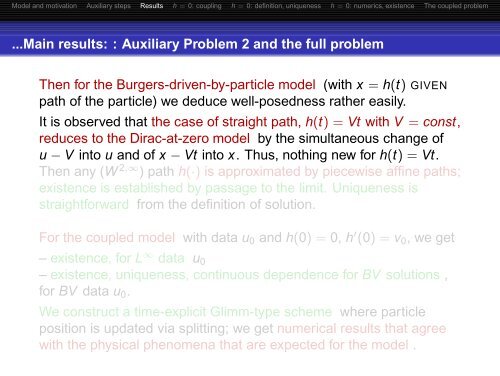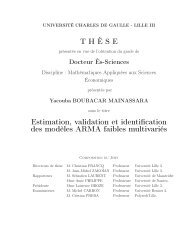A particle-in-Burgers model: theory and numerics - Laboratoire de ...
A particle-in-Burgers model: theory and numerics - Laboratoire de ...
A particle-in-Burgers model: theory and numerics - Laboratoire de ...
Create successful ePaper yourself
Turn your PDF publications into a flip-book with our unique Google optimized e-Paper software.
Mo<strong>de</strong>l <strong>and</strong> motivation Auxiliary steps Results h = 0: coupl<strong>in</strong>g h = 0: <strong>de</strong>f<strong>in</strong>ition, uniqueness h = 0: <strong>numerics</strong>, existence The coupled problem<br />
...Ma<strong>in</strong> results: : Auxiliary Problem 2 <strong>and</strong> the full problem<br />
Then for the <strong>Burgers</strong>-driven-by-<strong>particle</strong> <strong>mo<strong>de</strong>l</strong> (with x = h(t) GIVEN<br />
path of the <strong>particle</strong>) we <strong>de</strong>duce well-posedness rather easily.<br />
It is observed that the case of straight path, h(t) = Vt with V = const,<br />
reduces to the Dirac-at-zero <strong>mo<strong>de</strong>l</strong> by the simultaneous change of<br />
u − V <strong>in</strong>to u <strong>and</strong> of x − Vt <strong>in</strong>to x. Thus, noth<strong>in</strong>g new for h(t) = Vt.<br />
Then any (W 2,∞ ) path h(·) is approximated by piecewise aff<strong>in</strong>e paths;<br />
existence is established by passage to the limit. Uniqueness is<br />
straightforward from the <strong>de</strong>f<strong>in</strong>ition of solution.<br />
For the coupled <strong>mo<strong>de</strong>l</strong> with data u0 <strong>and</strong> h(0) = 0, h ′ (0) = v0, we get<br />
– existence, for L ∞ data u0<br />
– existence, uniqueness, cont<strong>in</strong>uous <strong>de</strong>pen<strong>de</strong>nce for BV solutions ,<br />
for BV data u0.<br />
We construct a time-explicit Glimm-type scheme where <strong>particle</strong><br />
position is updated via splitt<strong>in</strong>g; we get numerical results that agree<br />
with the physical phenomena that are expected for the <strong>mo<strong>de</strong>l</strong> .
















